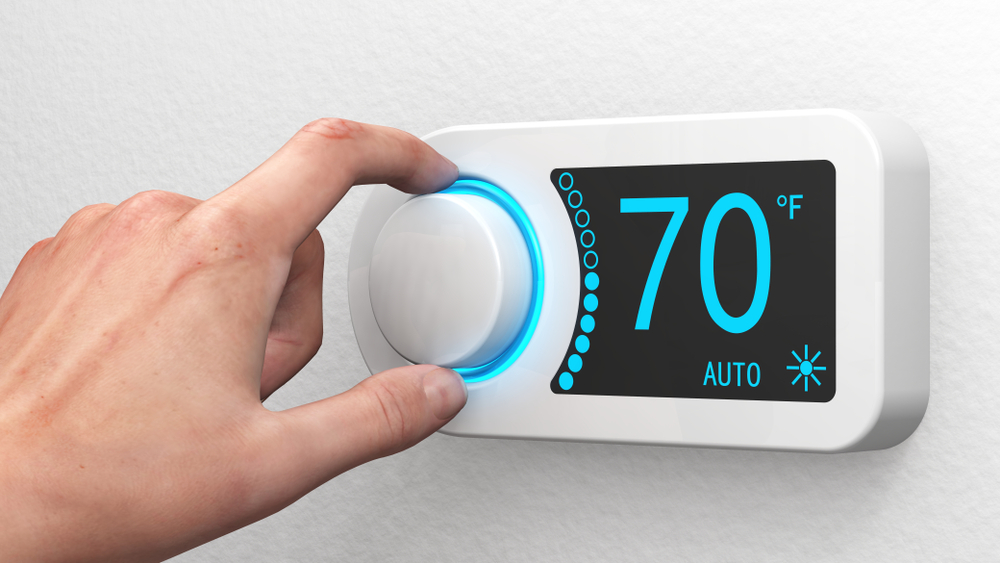Saving money and energy while maintaining a comfortable home sounds like a dream, right? With smart thermostats, it’s a reality. Intrigued? Join us as we delve into the world of smart thermostats, uncovering the latest brands and the features that make them a must-have in today’s homes.
Understanding Smart Thermostats
A smart thermostat is a device that offers more control over your home’s heating and cooling compared to traditional thermostats. They allow you to control your home’s temperature no matter where you are, using your smartphone, tablet, or computer. But what sets smart thermostats apart is their ability to learn from your behaviors and preferences, adjust accordingly, and even suggest energy-efficient settings.
Smart thermostats use machine learning algorithms to understand your schedule and preferences. Over time, the thermostat learns when you’re typically at home and when you’re away, it observes your preferred temperatures during specific times of the day, and begins to automate these settings for you. This level of automation not only provides optimal comfort but also results in significant energy savings.
Types of Smart Thermostats

Learning Thermostats
Learning thermostats, as the name suggests, are capable of learning your schedule and temperature preferences over time. They use this information to automate your home’s heating and cooling schedule, optimizing it for both comfort and energy efficiency. For example, if you like your home to be cooler at night and warmer in the morning, a learning thermostat will adjust the temperature on its own based on your past behavior.
Geofencing Thermostats
Geofencing thermostats use your smartphone’s location services to determine when you’re home and when you’re away. When you leave a certain radius around your home, the thermostat will switch to an energy-saving mode. Then, when you re-enter that radius, it will adjust the temperature to ensure your home is comfortable by the time you walk through the door. This type of thermostat is ideal for people with unpredictable schedules, as it doesn’t require a set schedule to function effectively.
Sensor-Based Thermostats
Sensor-based thermostats use a network of sensors placed throughout your home to monitor temperature and occupancy in different rooms. This allows the thermostat to adjust the temperature based on where people are in the house. For example, if the sensors detect that everyone is in the living room, the thermostat can lower the temperature in the unoccupied rooms to save energy.
Voice-Controlled Thermostats
Voice-controlled thermostats can be integrated with voice assistants like Alexa, Google Assistant, or Siri, allowing you to adjust your home’s temperature with simple voice commands. This is a convenient feature for those times when you’re in the middle of cooking dinner or watching a movie and don’t want to get up to adjust the thermostat manually.
Touchscreen Thermostats
Touchscreen thermostats feature a digital screen that allows you to adjust your home’s temperature and settings with a touch of your finger. Many touchscreen thermostats also display useful information like the current temperature, the weather forecast, and energy usage statistics.
Top Brands in the Smart Thermostat Market
| Brand | Most Popular Model | Features | Suitable For | User Reviews |
| Nest | Nest Learning Thermostat | Learns your schedule, Energy-saving, Remote control via app, Voice control | Those who want a thermostat that adapts to their lifestyle | Highly rated for its intuitive interface and learning capabilities |
| Ecobee | Ecobee SmartThermostat | Alexa built-in, Energy-saving, Remote control via app, Voice control, Room sensors | Those who want a thermostat with voice control and room-specific temperature settings | Appreciated for its remote sensor and easy installation |
| Honeywell | Honeywell Home T9 | Energy-saving, Remote control via app, Voice control, Room sensors | Those who want a simple, user-friendly smart thermostat | Known for its durability and wide compatibility |
| Emerson | Emerson Sensi Touch Wi-Fi Smart Thermostat | Energy-saving, Remote control via app, Voice control, Touchscreen | Those who want a budget-friendly smart thermostat with essential features | Praised for its simplicity and affordability |
Note: The brands listed above represent a selection of the top players in the smart thermostat market, each contributing unique features and advantages to cater to diverse consumer needs. However, it’s essential to conduct thorough research and consider individual preferences when selecting the ideal smart thermostat for your home.
How to Choose the Right Smart Thermostat For Your Home?

Compatibility with HVAC Systems
Before purchasing a smart thermostat, it’s crucial to ensure it’s compatible with your home’s heating, ventilation, and air conditioning (HVAC) system. Not all smart thermostats work with all types of HVAC systems, so it’s essential to check before you buy.
Functionality
Different smart thermostats come with different features. Some offer basic programmability and remote access, while others provide advanced features like learning your schedule, detecting when you’re home, and even integrating with voice assistants like Alexa or Google Assistant.
Ease of Installation
Some smart thermostats are easier to install than others. If you’re comfortable with DIY projects, you might be able to handle the installation yourself. However, some advanced models might require professional installation.
Energy Efficiency
One of the main benefits of smart thermostats is their potential to save energy. Look for models that provide energy usage reports, which can help you better understand and manage your energy consumption.
Price
Smart thermostats range in price from around $100 to over $300. While more expensive models often offer more features, they may not necessarily be better. Consider your needs and budget before making a decision.
Connectivity with Other Smart Devices
If you have other smart devices in your home, consider a smart thermostat that can integrate with these devices. This allows for a more cohesive and convenient smart home experience.
Common Mistakes to Avoid
When shopping for a smart thermostat, avoid choosing a model solely based on price. While budget is a factor, it’s also important to consider the features and long-term energy savings a more advanced model might offer. Additionally, ensure you have a strong and stable Wi-Fi connection, as most smart thermostats require this to function optimally.
10 Advantages of Smart Thermostats Over Traditional Thermostats
| Feature | Traditional Thermostat | Smart Thermostat |
|---|---|---|
| Design | Often features a simple, utilitarian design with physical buttons or dials. | Sleek, modern designs with touchscreen displays; often smaller and less obtrusive. |
| Functionality | Basic temperature control with manual adjustments. | Advanced features like learning abilities, occupancy sensors, and geofencing. |
| User Interface | Simple interface with basic displays. | Intuitive and user-friendly interfaces with detailed displays. |
| Energy Efficiency | No energy usage tracking or optimization features. | Provides energy reports and adjusts automatically for energy saving. |
| Cost | Generally cheaper upfront. | More expensive initially but can lead to savings on energy bills over time. |
| Digital Assistant Compatibility | No compatibility. | Often compatible with digital assistants like Amazon Alexa, Google Home, etc. |
| Mobile Connectivity | No mobile connectivity or remote control. | Allows for remote access and control via smartphone apps. |
| Installation | Easier to install as it usually involves simpler wiring. | Requires more complex installation, sometimes professional help needed. |
| Learning Capabilities | No learning capabilities. | Can learn your schedule and preferences over time for automatic adjustments. |
| Integration with Other Devices | Limited or no integration with other devices. | Can integrate with various smart home systems for a more unified home automation experience. |
Installation and Setup

Now that we’ve explored the benefits and features of smart thermostats, let’s touch on installation and setup. While the process may vary slightly depending on the brand and model, here are the general steps:
1. Removing Your Old Thermostat
Before installing your new smart thermostat, you’ll need to remove your old one. This typically involves unscrewing it from the wall and disconnecting the wires. Remember to take a picture of the wiring before you disconnect anything, as this can serve as a reference when installing your new device.
2. Installing Your Smart Thermostat
Next, you’ll install the base of your smart thermostat. This usually involves connecting the wires according to the manufacturer’s instructions (this is where the picture of your old thermostat’s wiring comes in handy), then attaching the base to the wall.
3. Setting up Your Smart Thermostat
Once your smart thermostat is installed, it’s time to set it up. This generally involves downloading the corresponding app on your smartphone and following the guided setup process. During this process, you’ll connect your thermostat to your Wi-Fi network, set your preferred temperatures for different times of the day, and enable any other features you want to use, like geofencing or integration with other smart devices.
While the installation and setup of a smart thermostat are relatively straightforward, it’s essential to follow the manufacturer’s instructions closely. If you’re uncomfortable with DIY installation, consider hiring a professional to ensure everything is set up correctly.
With your new smart thermostat installed and set up, you’re well on your way to a more comfortable, energy-efficient home.
Maintaining Your Smart Thermostat

Once your smart thermostat is installed and set up, it requires minimal maintenance. Here are a few tips to keep it running smoothly:
1. Regular Software Updates
Just like your smartphone or computer, your smart thermostat will periodically receive software updates from the manufacturer. These updates often include new features, security patches, and bug fixes. Ensure your device is set to automatically download and install these updates to keep it functioning optimally.
2. Cleaning
Your smart thermostat’s screen can get dusty or smudgy over time. Use a soft, dry cloth to gently wipe the screen clean. Avoid using harsh chemicals or abrasive materials that could damage the screen.
3. Battery Replacement
Some smart thermostats use batteries as a backup power source. If your device has batteries, check the manufacturer’s instructions for how often they should be replaced.
4. Professional Servicing
While not specifically related to the thermostat, it’s important to have your HVAC system professionally serviced at least once a year. A well-maintained system will work more efficiently and prolong the life of your smart thermostat.
Investing in a smart thermostat can be a busy homeowner’s best friend, offering maximum comfort and convenience. Smart thermostats let you control the temperature of your home from anywhere in the world, allowing you to come home to the perfect temperature at any time. They also provide energy-saving features that help lower utility bills and a wealth of insights on temperature patterns giving you greater control over your home environment.
While there are numerous brands available, focus on finding one that suits your needs and has all the must-have features necessary for it to run optimally. By getting creative with how you use this new device, you can easily turn your home into an even more comfortable place to live while also contributing to environmental sustainability efforts as well.
Step into the Future with Smart Space Automation LLC
Ready to upgrade your home with smart automation? Trust in Smart Space Automation LLC. We offer professional installation, repair, and maintenance services across Dallas, Frisco, Plano, Arlington, and other parts of Texas. Reach out today and let’s transform your living space into a smarter, more efficient home.

